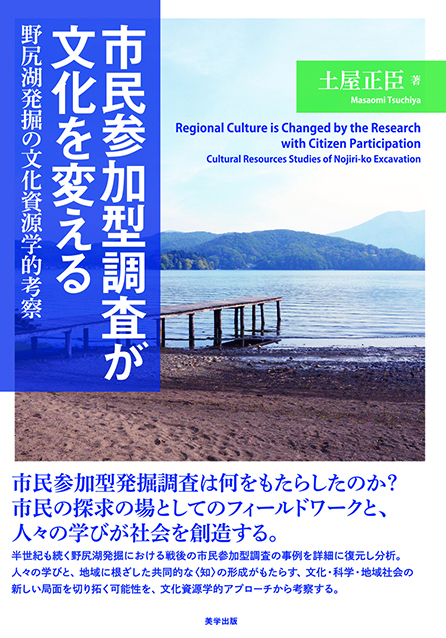
Title
Shimin-sanka-gata chosa ga bunka wo kaeru (Regional Culture is Changed by the Research with Citizen Participation - Cultural Resources Studies of Nojiri-ko Excavation)
Size
424 pages, A5 format, hardcover
Language
Japanese
Released
June, 2017
ISBN
978-4-902078-46-6
Published by
Bigaku Shuppan
Book Info
See Book Availability at Library
Japanese Page
Of the excavations conducted in Japan, more than 90% are so-called “administrative excavations,” which are those conducted by the government. The excavation research that most people imagine – where archeologists conduct an investigation for academic purposes – makes up less than 10% of all excavations. “Administrative excavation” refers to a government-run procedure in which ruins that will be destroyed by construction, such as a road or industrial park development, are investigated in advance and documented. In most cases, the administration of buried cultural properties in charge of such administrative excavation is under the jurisdiction of each board of education.
As the administration of buried cultural properties is under the jurisdiction of each board of education, one would naturally expect that the process and achievements of the excavation investigations would be channeled back into educational purposes that will result in people’s voluntary learning. However, in reality, that is not the case.
First, the reason such excavations are not being used for educational purposes could be attributed to the excavations’ limited time frames and limited budgets. Since excavations are conducted based on the premise that development projects are going to be undertaken, the number of days in which research can be conducted is stipulated by the development’s construction schedule. In addition, since the cost of excavation research is shouldered by the developers, consideration must be given to avoid placing an excessive burden on them. Thus, it is difficult to incorporate educational measures into the excavation research.
Second, the direct participation of civilians, who are non-professionals, is not welcome in such excavations because ensuring academic integrity is required in such research.
Third, there is a “tradition” of social education administration in which highly specialized officials in charge guide and teach civilians who do not possess the knowledge or background in a respectful and easy-to-understand manner (this is referred to as the “deficit model” in science communication theory). This is despite the fact that there are actually no adults who are educated by the government (Matsushita 1986).
In recent years, the Act for the Protection of Cultural Properties and the Act on the Organization and Operation of Local Educational Administration have been revised, with increasing discussions surrounding the utilization of cultural properties in areas such as urban planning and environment, welfare, and tourism – and not just in the field of education. This book, while recognizing the importance of these discussions, in particular re-examines the significance of placing the administration in charge of the protection of cultural properties and the administration for buried cultural properties in the realm of educational administration.
This book selected the Lake Nojiri excavation, which has been conducting continuous academic excavation by the Lake Nojiri in Shinano-cho, Nagano Prefecture, since 1962. The characteristics of the Lake Nojiri excavations are not limited to the scholarly nature of the discovery of fossils such as of Palaeoloxodon naumanni (Naumann elephants) and elks or paleolithic stone tools; it is also an excavation where anyone, from elementary school children to adults, can participate in the investigation and research, regardless of whether they have knowledge of geology or archaeology.
The Lake Nojiri excavation is not an administrative excavation, nor is its research field limited to archeology. For this reason, the excavation by itself will not serve as a new administrative excavation model. What the author focuses on in this research is the system in which anyone can participate in excavation and research.
The analysis results revealed that progressive and continuous learning was enabled by directly engaging people of different ages and from different fields in the investigation and research under a common field together. In addition, the residents of the remaining sites, who were not directly involved in the Lake Nojiri excavation at first, now facilitate the provision of meals and transportation services and serve as tour guides for outsiders coming to visit the ruins. Thus, a site for exploration and learning that attracts research participants across the nation has changed the local culture, as well.
[Reference] Keichi Matsushita (1986) The End of Social Education, Chikuma Shobō
(Written by: TSUCHIYA Masaomi / July 09, 2020)



